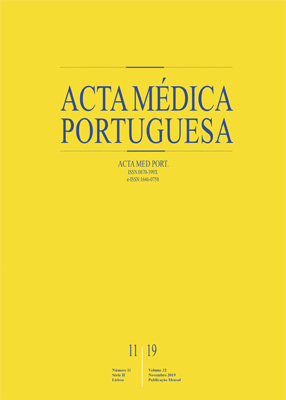Obstetric Admissions to the Intensive Care Unit: A 18-Year Review in a Portuguese Tertiary Care Centre
DOI:
https://doi.org/10.20344/amp.11410Keywords:
Intensive Care Units, Maternal Mortality, Pregnancy, Pregnancy ComplicationsAbstract
Introduction: Maternal mortality and morbidity are important indicators of the quality of health-care services. Obstetric admissions to an intensive care unit may be considered a marker of maternal morbidity. The aim of this study was to determine the incidence, maternal morbidity and mortality of pregnant and postpartum women who required admission to the intensive care unit.
Material and Methods: Retrospective analysis of all the obstetric patients admitted to the intensive care unit between 2000 and 2017.
Results: Ninety-three women required admission to intensive care (0.7 per 1000 deliveries, 0.8% of all adult admissions). Mean age was 30.3 years, mean gestational age was 33.6 weeks, 51 (54.8%) were primiparous, nine (9.7%) were pregnant of twins and five (5.4%) had not been followed during pregnancy. Eighty-four (90.3%) were admitted after immediate delivery. The most common reasons for admission were hypertensive disorders of pregnancy (35.5%) and obstetric haemorrhage (24.7%). Median length of stay was five days. Transfusion of blood products was needed in 23 (57.0%), artificial ventilation in 50 (53.8%) and use of vasopressors in 21 (22.6%). We observed four maternal deaths (4.3%). Most patients (95.7%) successfully recovered and were transferred to other departments. Sequential Organ Failure Assessment score was significantly associated with maternal mortality.
Discussion: Our results are comparable to those obtained in other studies. Maternal mortality was comparable to maternal mortality in developed countries.
Conclusion: The incidence of obstetric admissions to the intensive care unit was 0.8% and 0.7 per 1000 deliveries. Hypertensive disorders of pregnancy were the main causes of admission. Maternal mortality was 4.3%. Studies of maternal morbidity are important and can help to improve the quality of health care services.
Downloads
Downloads
Published
How to Cite
Issue
Section
License
All the articles published in the AMP are open access and comply with the requirements of funding agencies or academic institutions. The AMP is governed by the terms of the Creative Commons ‘Attribution – Non-Commercial Use - (CC-BY-NC)’ license, regarding the use by third parties.
It is the author’s responsibility to obtain approval for the reproduction of figures, tables, etc. from other publications.
Upon acceptance of an article for publication, the authors will be asked to complete the ICMJE “Copyright Liability and Copyright Sharing Statement “(http://www.actamedicaportuguesa.com/info/AMP-NormasPublicacao.pdf) and the “Declaration of Potential Conflicts of Interest” (http:// www.icmje.org/conflicts-of-interest). An e-mail will be sent to the corresponding author to acknowledge receipt of the manuscript.
After publication, the authors are authorised to make their articles available in repositories of their institutions of origin, as long as they always mention where they were published and according to the Creative Commons license.









